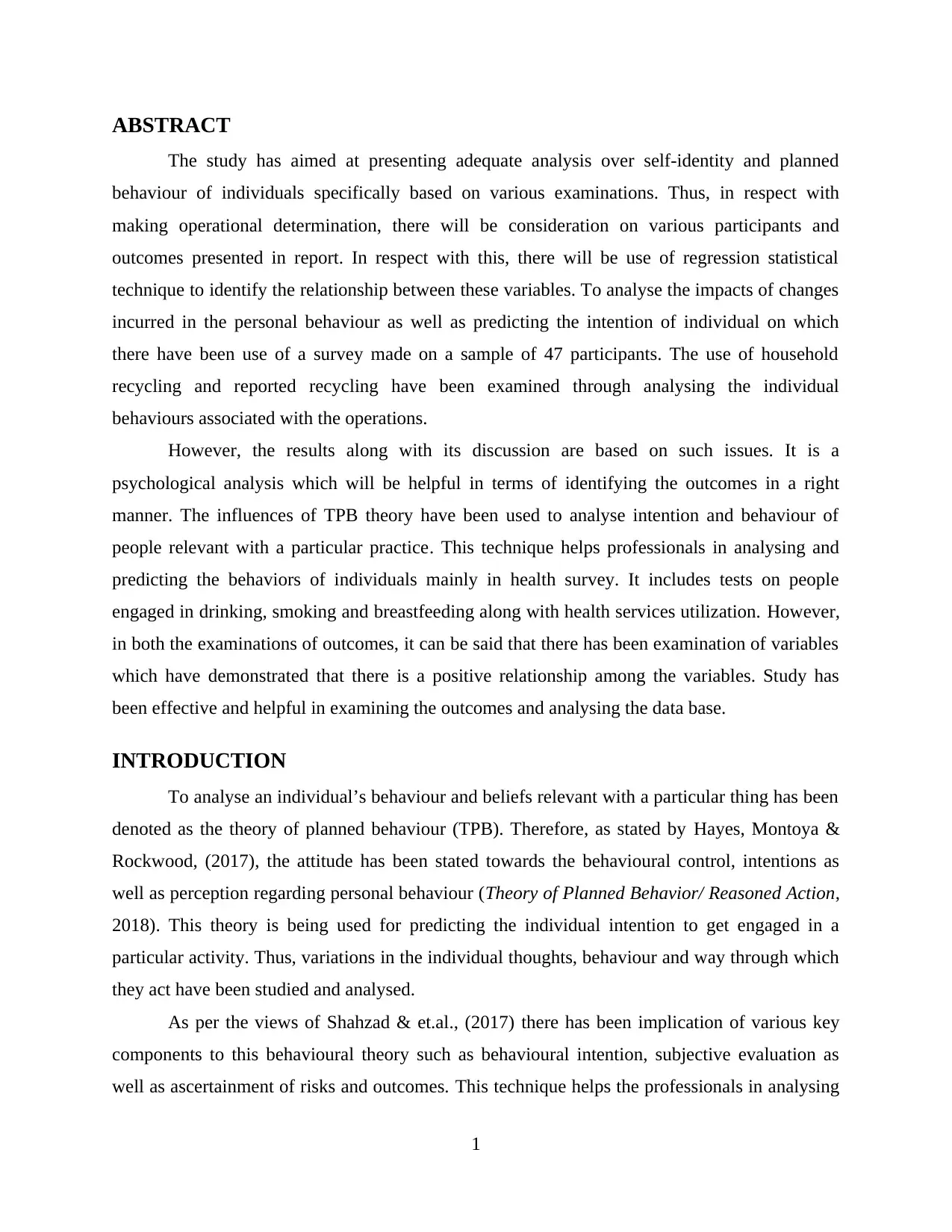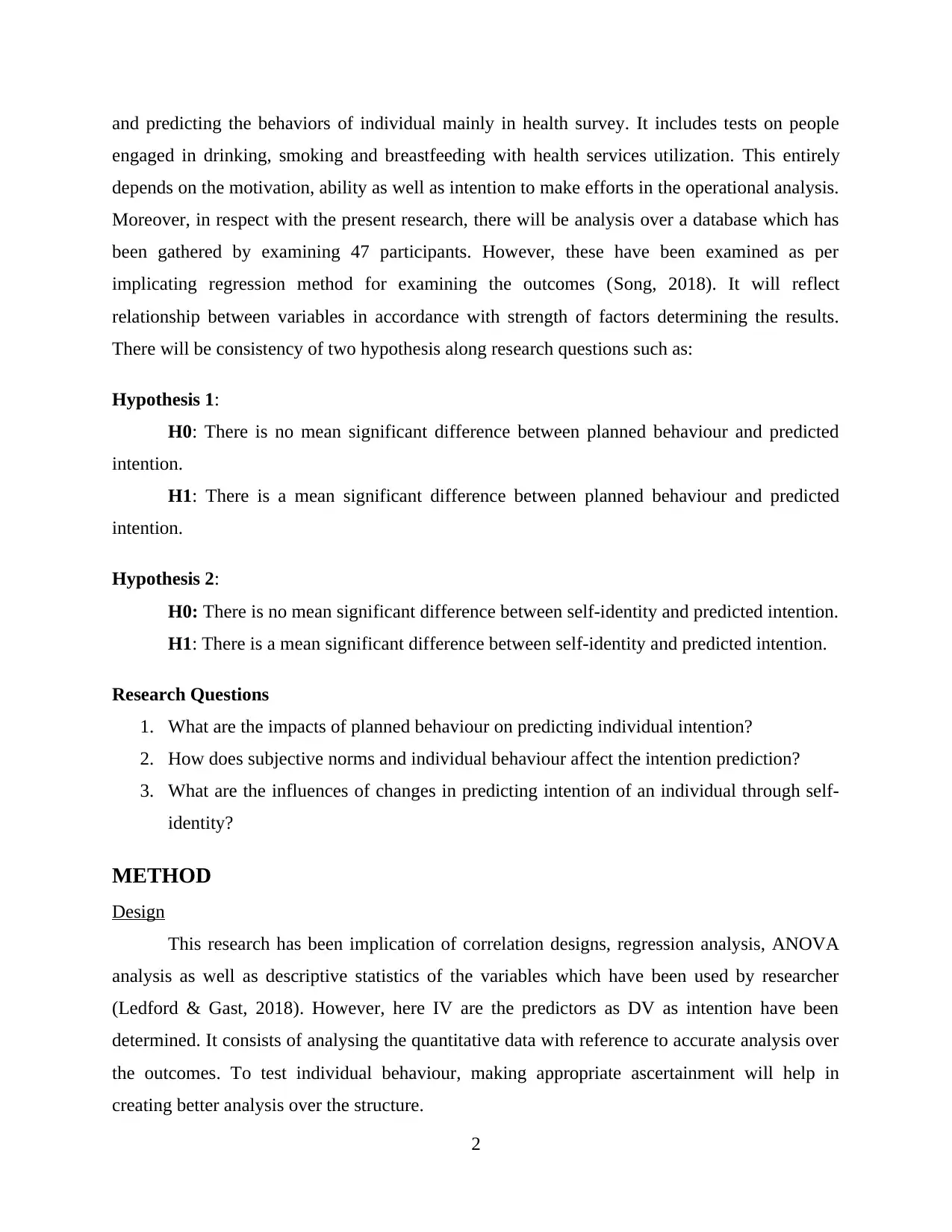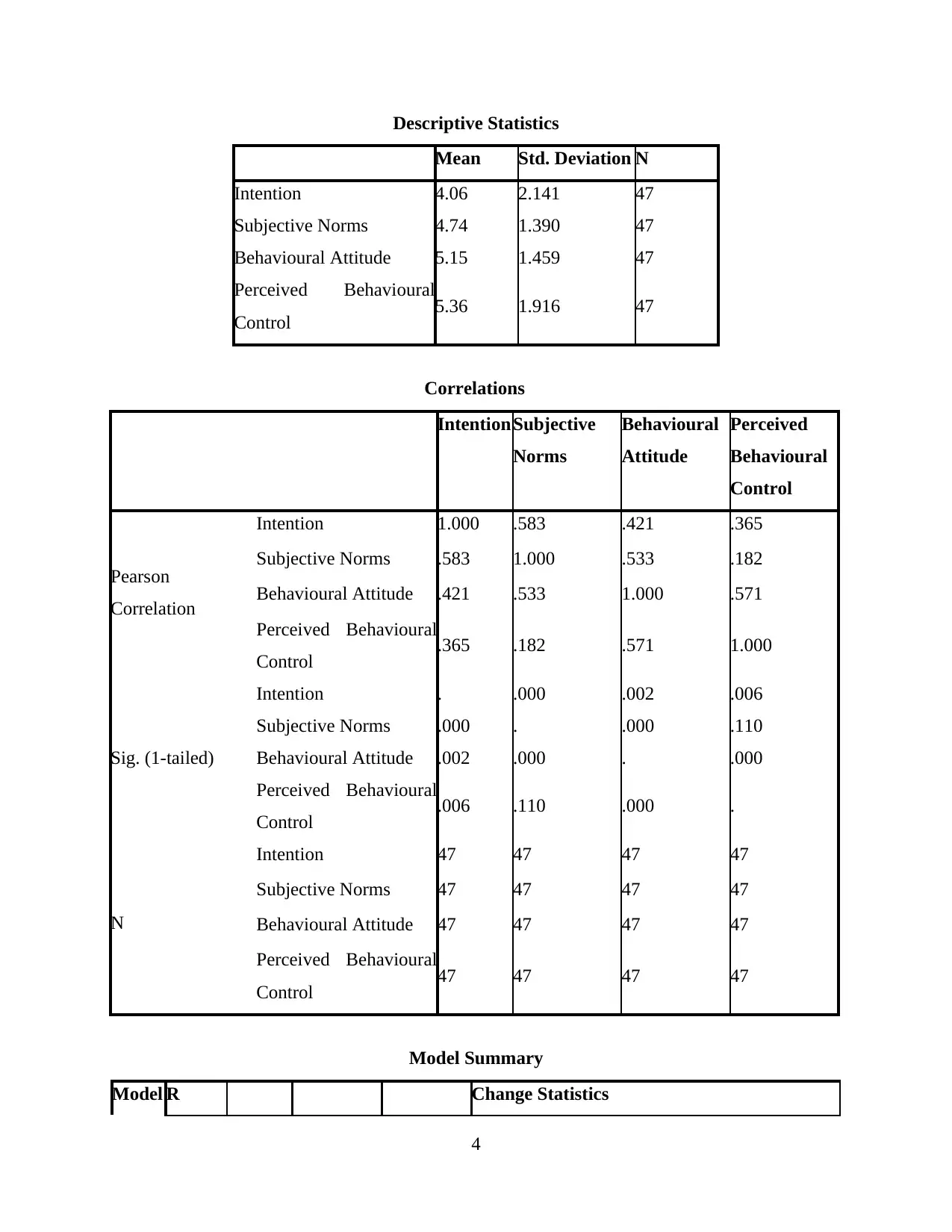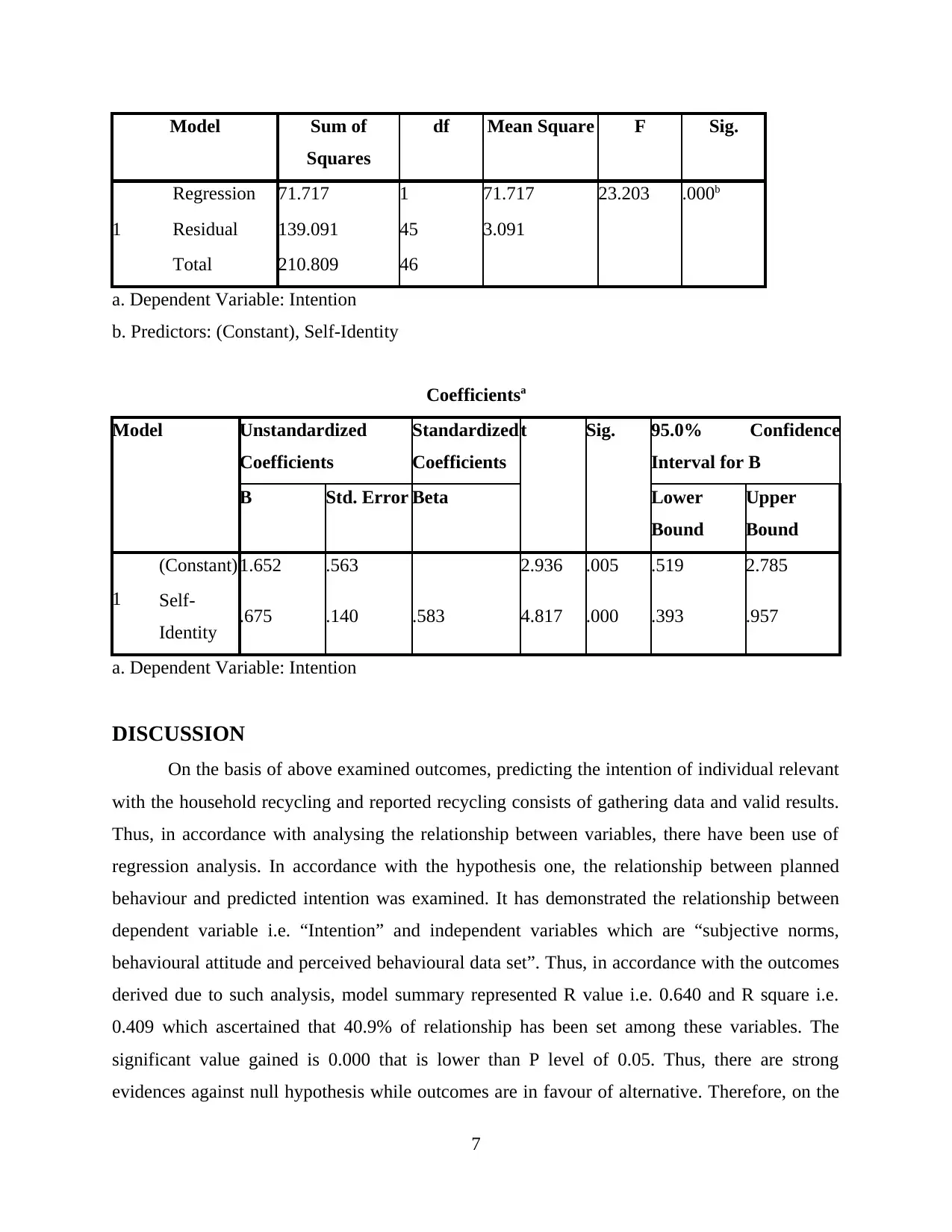Psychology Report: Examining Planned Behavior and Intention Prediction
VerifiedAdded on 2021/01/03
|10
|1971
|93
Report
AI Summary
This psychology report delves into the theory of planned behavior (TPB) to analyze individual intentions, specifically focusing on household recycling and reported recycling behaviors. The study employs regression analysis to examine the relationships between variables, including planned behavior, subjective norms, behavioral attitudes, perceived behavioral control, and self-identity. The research, conducted with a sample of 47 participants, tests two hypotheses: the impact of planned behavior and self-identity on intention prediction. The findings indicate a significant relationship between planned behavior and predicted intention, as well as between self-identity and predicted intention. The report includes descriptive statistics, correlation analyses, and model summaries to support the conclusions, highlighting the influence of various factors on an individual's predicted intentions.

PSYCHOLOGY
Paraphrase This Document
Need a fresh take? Get an instant paraphrase of this document with our AI Paraphraser

TABLE OF CONTENTS
ABSTRACT....................................................................................................................................1
INTRODUCTION...........................................................................................................................1
METHOD........................................................................................................................................2
Design..........................................................................................................................................2
Participants..................................................................................................................................3
Material........................................................................................................................................3
Procedure.....................................................................................................................................3
RESULTS........................................................................................................................................3
Regression....................................................................................................................................3
Regression....................................................................................................................................6
DISCUSSION..................................................................................................................................7
REFERENCES................................................................................................................................9
ABSTRACT....................................................................................................................................1
INTRODUCTION...........................................................................................................................1
METHOD........................................................................................................................................2
Design..........................................................................................................................................2
Participants..................................................................................................................................3
Material........................................................................................................................................3
Procedure.....................................................................................................................................3
RESULTS........................................................................................................................................3
Regression....................................................................................................................................3
Regression....................................................................................................................................6
DISCUSSION..................................................................................................................................7
REFERENCES................................................................................................................................9

ABSTRACT
The study has aimed at presenting adequate analysis over self-identity and planned
behaviour of individuals specifically based on various examinations. Thus, in respect with
making operational determination, there will be consideration on various participants and
outcomes presented in report. In respect with this, there will be use of regression statistical
technique to identify the relationship between these variables. To analyse the impacts of changes
incurred in the personal behaviour as well as predicting the intention of individual on which
there have been use of a survey made on a sample of 47 participants. The use of household
recycling and reported recycling have been examined through analysing the individual
behaviours associated with the operations.
However, the results along with its discussion are based on such issues. It is a
psychological analysis which will be helpful in terms of identifying the outcomes in a right
manner. The influences of TPB theory have been used to analyse intention and behaviour of
people relevant with a particular practice. This technique helps professionals in analysing and
predicting the behaviors of individuals mainly in health survey. It includes tests on people
engaged in drinking, smoking and breastfeeding along with health services utilization. However,
in both the examinations of outcomes, it can be said that there has been examination of variables
which have demonstrated that there is a positive relationship among the variables. Study has
been effective and helpful in examining the outcomes and analysing the data base.
INTRODUCTION
To analyse an individual’s behaviour and beliefs relevant with a particular thing has been
denoted as the theory of planned behaviour (TPB). Therefore, as stated by Hayes, Montoya &
Rockwood, (2017), the attitude has been stated towards the behavioural control, intentions as
well as perception regarding personal behaviour (Theory of Planned Behavior/ Reasoned Action,
2018). This theory is being used for predicting the individual intention to get engaged in a
particular activity. Thus, variations in the individual thoughts, behaviour and way through which
they act have been studied and analysed.
As per the views of Shahzad & et.al., (2017) there has been implication of various key
components to this behavioural theory such as behavioural intention, subjective evaluation as
well as ascertainment of risks and outcomes. This technique helps the professionals in analysing
1
The study has aimed at presenting adequate analysis over self-identity and planned
behaviour of individuals specifically based on various examinations. Thus, in respect with
making operational determination, there will be consideration on various participants and
outcomes presented in report. In respect with this, there will be use of regression statistical
technique to identify the relationship between these variables. To analyse the impacts of changes
incurred in the personal behaviour as well as predicting the intention of individual on which
there have been use of a survey made on a sample of 47 participants. The use of household
recycling and reported recycling have been examined through analysing the individual
behaviours associated with the operations.
However, the results along with its discussion are based on such issues. It is a
psychological analysis which will be helpful in terms of identifying the outcomes in a right
manner. The influences of TPB theory have been used to analyse intention and behaviour of
people relevant with a particular practice. This technique helps professionals in analysing and
predicting the behaviors of individuals mainly in health survey. It includes tests on people
engaged in drinking, smoking and breastfeeding along with health services utilization. However,
in both the examinations of outcomes, it can be said that there has been examination of variables
which have demonstrated that there is a positive relationship among the variables. Study has
been effective and helpful in examining the outcomes and analysing the data base.
INTRODUCTION
To analyse an individual’s behaviour and beliefs relevant with a particular thing has been
denoted as the theory of planned behaviour (TPB). Therefore, as stated by Hayes, Montoya &
Rockwood, (2017), the attitude has been stated towards the behavioural control, intentions as
well as perception regarding personal behaviour (Theory of Planned Behavior/ Reasoned Action,
2018). This theory is being used for predicting the individual intention to get engaged in a
particular activity. Thus, variations in the individual thoughts, behaviour and way through which
they act have been studied and analysed.
As per the views of Shahzad & et.al., (2017) there has been implication of various key
components to this behavioural theory such as behavioural intention, subjective evaluation as
well as ascertainment of risks and outcomes. This technique helps the professionals in analysing
1
⊘ This is a preview!⊘
Do you want full access?
Subscribe today to unlock all pages.

Trusted by 1+ million students worldwide

and predicting the behaviors of individual mainly in health survey. It includes tests on people
engaged in drinking, smoking and breastfeeding with health services utilization. This entirely
depends on the motivation, ability as well as intention to make efforts in the operational analysis.
Moreover, in respect with the present research, there will be analysis over a database which has
been gathered by examining 47 participants. However, these have been examined as per
implicating regression method for examining the outcomes (Song, 2018). It will reflect
relationship between variables in accordance with strength of factors determining the results.
There will be consistency of two hypothesis along research questions such as:
Hypothesis 1:
H0: There is no mean significant difference between planned behaviour and predicted
intention.
H1: There is a mean significant difference between planned behaviour and predicted
intention.
Hypothesis 2:
H0: There is no mean significant difference between self-identity and predicted intention.
H1: There is a mean significant difference between self-identity and predicted intention.
Research Questions
1. What are the impacts of planned behaviour on predicting individual intention?
2. How does subjective norms and individual behaviour affect the intention prediction?
3. What are the influences of changes in predicting intention of an individual through self-
identity?
METHOD
Design
This research has been implication of correlation designs, regression analysis, ANOVA
analysis as well as descriptive statistics of the variables which have been used by researcher
(Ledford & Gast, 2018). However, here IV are the predictors as DV as intention have been
determined. It consists of analysing the quantitative data with reference to accurate analysis over
the outcomes. To test individual behaviour, making appropriate ascertainment will help in
creating better analysis over the structure.
2
engaged in drinking, smoking and breastfeeding with health services utilization. This entirely
depends on the motivation, ability as well as intention to make efforts in the operational analysis.
Moreover, in respect with the present research, there will be analysis over a database which has
been gathered by examining 47 participants. However, these have been examined as per
implicating regression method for examining the outcomes (Song, 2018). It will reflect
relationship between variables in accordance with strength of factors determining the results.
There will be consistency of two hypothesis along research questions such as:
Hypothesis 1:
H0: There is no mean significant difference between planned behaviour and predicted
intention.
H1: There is a mean significant difference between planned behaviour and predicted
intention.
Hypothesis 2:
H0: There is no mean significant difference between self-identity and predicted intention.
H1: There is a mean significant difference between self-identity and predicted intention.
Research Questions
1. What are the impacts of planned behaviour on predicting individual intention?
2. How does subjective norms and individual behaviour affect the intention prediction?
3. What are the influences of changes in predicting intention of an individual through self-
identity?
METHOD
Design
This research has been implication of correlation designs, regression analysis, ANOVA
analysis as well as descriptive statistics of the variables which have been used by researcher
(Ledford & Gast, 2018). However, here IV are the predictors as DV as intention have been
determined. It consists of analysing the quantitative data with reference to accurate analysis over
the outcomes. To test individual behaviour, making appropriate ascertainment will help in
creating better analysis over the structure.
2
Paraphrase This Document
Need a fresh take? Get an instant paraphrase of this document with our AI Paraphraser

Participants
Considering all ethics and norms relevant with survey in analysing the research
outcomes, 47 (N) participants were selected. They were examined on their behaviour and
relation with other variables in health survey statistics (Quinlan & et.al., 2018). However, it has
been organised without discriminating the sample in gender. The database has been built up by
considering the variations in individual behaviour relevant with various aspects and changes in
individual perception. Among the database of 147 participants, researcher has taken sample of 47
participants to be examined.
Material
To analyse the behaviour of participants based on household and reported recycling is
being measured by implicating this test. Therefore, such examination of behaviour will be
helpful in relation with predicting the intention of participants. With the influence of TPB theory,
there has been use of technique to analyse intention and behaviour of people relevant with a
particular practice. Thus, in this case, analysing the changes incurred in the sample of 47
participant’s behaviour with reference to household recycling and reported recycling will be
examined.
Procedure
There has been analysis over the perceived behavioural control, subjective norms,
behavioural attitude and self-identity in relation with predicting the intention (Sun & Lipsitz,
2018). It consists of implicating various statistical tools and tests such as Regression analysis to
examine the relation between variables. In includes details like correlation, ANOVA analysis as
well as model summary of data set.
RESULTS
Regression
Hypothesis 1:
H0: There is no mean significant difference between planned behaviour and predicted
intention.
H1: There is a mean significant difference between planned behaviour and predicted
intention.
3
Considering all ethics and norms relevant with survey in analysing the research
outcomes, 47 (N) participants were selected. They were examined on their behaviour and
relation with other variables in health survey statistics (Quinlan & et.al., 2018). However, it has
been organised without discriminating the sample in gender. The database has been built up by
considering the variations in individual behaviour relevant with various aspects and changes in
individual perception. Among the database of 147 participants, researcher has taken sample of 47
participants to be examined.
Material
To analyse the behaviour of participants based on household and reported recycling is
being measured by implicating this test. Therefore, such examination of behaviour will be
helpful in relation with predicting the intention of participants. With the influence of TPB theory,
there has been use of technique to analyse intention and behaviour of people relevant with a
particular practice. Thus, in this case, analysing the changes incurred in the sample of 47
participant’s behaviour with reference to household recycling and reported recycling will be
examined.
Procedure
There has been analysis over the perceived behavioural control, subjective norms,
behavioural attitude and self-identity in relation with predicting the intention (Sun & Lipsitz,
2018). It consists of implicating various statistical tools and tests such as Regression analysis to
examine the relation between variables. In includes details like correlation, ANOVA analysis as
well as model summary of data set.
RESULTS
Regression
Hypothesis 1:
H0: There is no mean significant difference between planned behaviour and predicted
intention.
H1: There is a mean significant difference between planned behaviour and predicted
intention.
3

Descriptive Statistics
Mean Std. Deviation N
Intention 4.06 2.141 47
Subjective Norms 4.74 1.390 47
Behavioural Attitude 5.15 1.459 47
Perceived Behavioural
Control 5.36 1.916 47
Correlations
Intention Subjective
Norms
Behavioural
Attitude
Perceived
Behavioural
Control
Pearson
Correlation
Intention 1.000 .583 .421 .365
Subjective Norms .583 1.000 .533 .182
Behavioural Attitude .421 .533 1.000 .571
Perceived Behavioural
Control .365 .182 .571 1.000
Sig. (1-tailed)
Intention . .000 .002 .006
Subjective Norms .000 . .000 .110
Behavioural Attitude .002 .000 . .000
Perceived Behavioural
Control .006 .110 .000 .
N
Intention 47 47 47 47
Subjective Norms 47 47 47 47
Behavioural Attitude 47 47 47 47
Perceived Behavioural
Control 47 47 47 47
Model Summary
Model R Change Statistics
4
Mean Std. Deviation N
Intention 4.06 2.141 47
Subjective Norms 4.74 1.390 47
Behavioural Attitude 5.15 1.459 47
Perceived Behavioural
Control 5.36 1.916 47
Correlations
Intention Subjective
Norms
Behavioural
Attitude
Perceived
Behavioural
Control
Pearson
Correlation
Intention 1.000 .583 .421 .365
Subjective Norms .583 1.000 .533 .182
Behavioural Attitude .421 .533 1.000 .571
Perceived Behavioural
Control .365 .182 .571 1.000
Sig. (1-tailed)
Intention . .000 .002 .006
Subjective Norms .000 . .000 .110
Behavioural Attitude .002 .000 . .000
Perceived Behavioural
Control .006 .110 .000 .
N
Intention 47 47 47 47
Subjective Norms 47 47 47 47
Behavioural Attitude 47 47 47 47
Perceived Behavioural
Control 47 47 47 47
Model Summary
Model R Change Statistics
4
⊘ This is a preview!⊘
Do you want full access?
Subscribe today to unlock all pages.

Trusted by 1+ million students worldwide

R
Square
Adjusted
R Square
Std. Error
of the
Estimate
R Square
Change
F
Change
df1 df2 Sig. F
Change
1 .640a .409 .368 1.702 .409 9.934 3 43 .000
a. Predictors: (Constant), Perceived Behavioural Control, Subjective Norms, Behavioural
Attitude
ANOVAa
Model Sum of
Squares
df Mean Square F Sig.
1
Regression 86.294 3 28.765 9.934 .000b
Residual 124.515 43 2.896
Total 210.809 46
a. Dependent Variable: Intention
b. Predictors: (Constant), Perceived Behavioural Control, Subjective Norms,
Behavioural Attitude
Coefficientsa
Model Unstandardized
Coefficients
Standardized
Coefficients
t Sig. 95.0% Confidence
Interval for B
B Std.
Error
Beta Lower
Bound
Upper
Bound
1
(Constant) -1.394 1.075 -1.296 .202 -3.562 .775
Subjective Norms .845 .217 .549 3.898 .000 .408 1.282
Behavioural
Attitude -.050 .247 -.034 -.201 .842 -.549 .449
Perceived
Behavioural
Control
.318 .162 .285 1.962 .056 -.009 .645
5
Square
Adjusted
R Square
Std. Error
of the
Estimate
R Square
Change
F
Change
df1 df2 Sig. F
Change
1 .640a .409 .368 1.702 .409 9.934 3 43 .000
a. Predictors: (Constant), Perceived Behavioural Control, Subjective Norms, Behavioural
Attitude
ANOVAa
Model Sum of
Squares
df Mean Square F Sig.
1
Regression 86.294 3 28.765 9.934 .000b
Residual 124.515 43 2.896
Total 210.809 46
a. Dependent Variable: Intention
b. Predictors: (Constant), Perceived Behavioural Control, Subjective Norms,
Behavioural Attitude
Coefficientsa
Model Unstandardized
Coefficients
Standardized
Coefficients
t Sig. 95.0% Confidence
Interval for B
B Std.
Error
Beta Lower
Bound
Upper
Bound
1
(Constant) -1.394 1.075 -1.296 .202 -3.562 .775
Subjective Norms .845 .217 .549 3.898 .000 .408 1.282
Behavioural
Attitude -.050 .247 -.034 -.201 .842 -.549 .449
Perceived
Behavioural
Control
.318 .162 .285 1.962 .056 -.009 .645
5
Paraphrase This Document
Need a fresh take? Get an instant paraphrase of this document with our AI Paraphraser

a. Dependent Variable: Intention
Regression
Hypothesis 2:
H0: There is no mean significant difference between self-identity and predicted intention.
H1: There is a mean significant difference between self-identity and predicted intention.
Descriptive Statistics
Mean Std. Deviation N
Intention 4.06 2.141 47
Self-Identity 3.57 1.850 47
Correlations
Intention Self-Identity
Pearson Correlation Intention 1.000 .583
Self-Identity .583 1.000
Sig. (1-tailed) Intention . .000
Self-Identity .000 .
N Intention 47 47
Self-Identity 47 47
Model Summary
Model R R
Square
Adjusted
R Square
Std. Error
of the
Estimate
Change Statistics
R Square
Change
F
Change
df1 df2 Sig. F
Change
1 .583a .340 .326 1.758 .340 23.203 1 45 .000
a. Predictors: (Constant), Self-Identity
ANOVAa
6
Regression
Hypothesis 2:
H0: There is no mean significant difference between self-identity and predicted intention.
H1: There is a mean significant difference between self-identity and predicted intention.
Descriptive Statistics
Mean Std. Deviation N
Intention 4.06 2.141 47
Self-Identity 3.57 1.850 47
Correlations
Intention Self-Identity
Pearson Correlation Intention 1.000 .583
Self-Identity .583 1.000
Sig. (1-tailed) Intention . .000
Self-Identity .000 .
N Intention 47 47
Self-Identity 47 47
Model Summary
Model R R
Square
Adjusted
R Square
Std. Error
of the
Estimate
Change Statistics
R Square
Change
F
Change
df1 df2 Sig. F
Change
1 .583a .340 .326 1.758 .340 23.203 1 45 .000
a. Predictors: (Constant), Self-Identity
ANOVAa
6

Model Sum of
Squares
df Mean Square F Sig.
1
Regression 71.717 1 71.717 23.203 .000b
Residual 139.091 45 3.091
Total 210.809 46
a. Dependent Variable: Intention
b. Predictors: (Constant), Self-Identity
Coefficientsa
Model Unstandardized
Coefficients
Standardized
Coefficients
t Sig. 95.0% Confidence
Interval for B
B Std. Error Beta Lower
Bound
Upper
Bound
1
(Constant)1.652 .563 2.936 .005 .519 2.785
Self-
Identity .675 .140 .583 4.817 .000 .393 .957
a. Dependent Variable: Intention
DISCUSSION
On the basis of above examined outcomes, predicting the intention of individual relevant
with the household recycling and reported recycling consists of gathering data and valid results.
Thus, in accordance with analysing the relationship between variables, there have been use of
regression analysis. In accordance with the hypothesis one, the relationship between planned
behaviour and predicted intention was examined. It has demonstrated the relationship between
dependent variable i.e. “Intention” and independent variables which are “subjective norms,
behavioural attitude and perceived behavioural data set”. Thus, in accordance with the outcomes
derived due to such analysis, model summary represented R value i.e. 0.640 and R square i.e.
0.409 which ascertained that 40.9% of relationship has been set among these variables. The
significant value gained is 0.000 that is lower than P level of 0.05. Thus, there are strong
evidences against null hypothesis while outcomes are in favour of alternative. Therefore, on the
7
Squares
df Mean Square F Sig.
1
Regression 71.717 1 71.717 23.203 .000b
Residual 139.091 45 3.091
Total 210.809 46
a. Dependent Variable: Intention
b. Predictors: (Constant), Self-Identity
Coefficientsa
Model Unstandardized
Coefficients
Standardized
Coefficients
t Sig. 95.0% Confidence
Interval for B
B Std. Error Beta Lower
Bound
Upper
Bound
1
(Constant)1.652 .563 2.936 .005 .519 2.785
Self-
Identity .675 .140 .583 4.817 .000 .393 .957
a. Dependent Variable: Intention
DISCUSSION
On the basis of above examined outcomes, predicting the intention of individual relevant
with the household recycling and reported recycling consists of gathering data and valid results.
Thus, in accordance with analysing the relationship between variables, there have been use of
regression analysis. In accordance with the hypothesis one, the relationship between planned
behaviour and predicted intention was examined. It has demonstrated the relationship between
dependent variable i.e. “Intention” and independent variables which are “subjective norms,
behavioural attitude and perceived behavioural data set”. Thus, in accordance with the outcomes
derived due to such analysis, model summary represented R value i.e. 0.640 and R square i.e.
0.409 which ascertained that 40.9% of relationship has been set among these variables. The
significant value gained is 0.000 that is lower than P level of 0.05. Thus, there are strong
evidences against null hypothesis while outcomes are in favour of alternative. Therefore, on the
7
⊘ This is a preview!⊘
Do you want full access?
Subscribe today to unlock all pages.

Trusted by 1+ million students worldwide

basis of such results, it can be said that there is a mean significant difference between planned
behaviour and predicted intention.
On the other side, relationship between “self-identity” as an independent variable while
“predicted intention” as dependent variables were examined. Thus, with the influence of
regression outcomes on which R value is 0.583 and R square is 0.340, it is 34% or relationship
has been set among these variables. Moreover, there has been development of positive
relationship among the variables which has been examined by the researchers. Considering the
significant value of outcomes which is 0.000 such as less than level of P value 0.05, similarly,
there will be rejection to null hypothesis while acceptance to alternative hypothesis of database.
It represents that there is a mean significant difference between self-identity and predicted
intention. However, in both the examinations of outcomes, it can be said that there has been
examination of variables which have demonstrated that there is a positive relationship among the
variables. Thus, impacts of various factors such as subjective, norms, behavioural attitudes,
perceived behavioural control and self- identity will affect the predicted intention of individuals.
8
behaviour and predicted intention.
On the other side, relationship between “self-identity” as an independent variable while
“predicted intention” as dependent variables were examined. Thus, with the influence of
regression outcomes on which R value is 0.583 and R square is 0.340, it is 34% or relationship
has been set among these variables. Moreover, there has been development of positive
relationship among the variables which has been examined by the researchers. Considering the
significant value of outcomes which is 0.000 such as less than level of P value 0.05, similarly,
there will be rejection to null hypothesis while acceptance to alternative hypothesis of database.
It represents that there is a mean significant difference between self-identity and predicted
intention. However, in both the examinations of outcomes, it can be said that there has been
examination of variables which have demonstrated that there is a positive relationship among the
variables. Thus, impacts of various factors such as subjective, norms, behavioural attitudes,
perceived behavioural control and self- identity will affect the predicted intention of individuals.
8
1 out of 10
Related Documents
Your All-in-One AI-Powered Toolkit for Academic Success.
+13062052269
info@desklib.com
Available 24*7 on WhatsApp / Email
![[object Object]](/_next/static/media/star-bottom.7253800d.svg)
Unlock your academic potential
Copyright © 2020–2025 A2Z Services. All Rights Reserved. Developed and managed by ZUCOL.





